Free Instagram competitor analysis: the ultimate guide

- What is Instagram competitor analysis
- Find your competitors on Instagram
- How to choose Instagram competitors for your analysis
- Metrics to include in your Instagram competitor analysis
- Account statistics
- Content analysis
- Posting statistics
- Hashtags
- Comment section
- Use free Instagram competitor analysis tools
- Phlanx
- Inflact
- How to use Instagram competitor analysis in your marketing strategy
- Set achievable goals
- Create a content plan
- Make a good offer
- How to beat the competition on Instagram
- To sum up
Let's start with defining the terms to make sure you can find what you need on this page. Instagram competitor analysis is researching IG accounts in your niche. This includes estimating their influence and understanding what they do for it.
Instagram competitor analysis tells what exactly success you can expect. It tells you what your rivals have on average. How many likes and followers they get, for instance. This allows you to be reasonable when setting goals and estimating your performance.
Also, when you analyze your Instagram competitors, you get an insight of a perfect content plan. You know how to post on social media to develop your brand.
First of all, find your Instagram competitors to analyze. Use search in the app to find their accounts:
- Go to the Explore tab.
- Type a word in the search bar.


If you already know your competitors, find their Instagram accounts. Type one of the brands' names in the search bar. You will see the rival's account on the appeared list. Find all the rivals you know this way.


If you don't know your Instagram competitors or need more to those you are going to analyze, use keywords. Brands often include them in their usernames and names. So try your niche keywords to find your rivals on Instagram. For example, if you are a marketing coach, type "marketing" in the search.

When you search for new Instagram competitors using keywords, you see five tabs. You can find your rivals in these tabs:
- Accounts. You usually see big Instagram accounts at the top. You should include them on the list to know how to get the same success.
- Tags. Tap a hashtag and you will see posts with this tag. You need posts in both Top and Recent tabs. They are posted by your Instagram competitors.

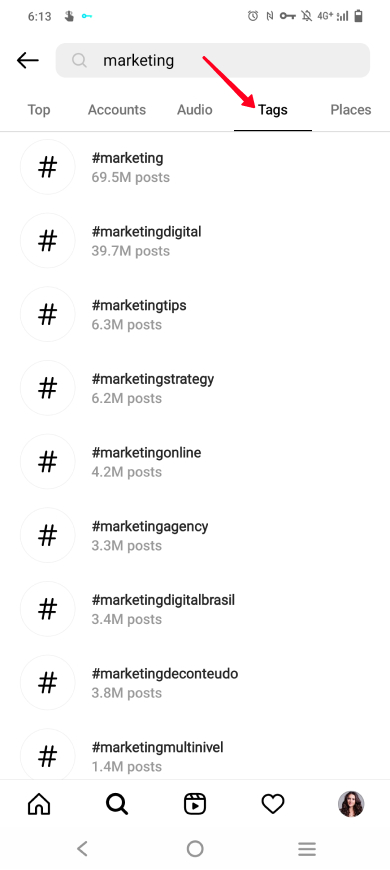
So now you know how to find your Instagram competitors for the analysis. There are probably a lot of them. Let's choose the best ones to analyze.
You may have found a lot of competitors on Instagram to analyze. Choose several that can give you good insights.
Analyze both big and small Instagram accounts. Big accounts belong to the industry leaders. Analyze them to know trends and what is possible to achieve in your niche. You also should analyze accounts which have a bit bigger number of followers that yours. They will tell you what you can achieve in the near future and what you should do for this.
There is no accurate number for how many Instagram competitors to analyze. Choose all the best examples. At the same time, be reasonable and remember you will have to check accounts one by one. 5 big accounts and 5 accounts like yours may be enough.
Now that you know what accounts to use for your Instagram competitor analysis, let's figure out what to look for in these accounts. We are going to analyze the metrics and content that give you insights into their success and failures.
You can analyze these metrics in the Instagram competitors' accounts manually. All the data for the calculations is available on profile pages. Or you can use free competitive analysis tools, but first, read below how to understand what the tools will show you.
Start your Instagram competitor analysis with account statistics. Find the average numbers for the big accounts to know what is possible to get in your industry, these are for your long-term goals. Also, find the average numbers for the smaller accounts you've chosen to know what you can expect from promotion on Instagram currently.
- Follower count. Know how much influence you can have.
- Follower growth. Know the possible pace of your Instagram account growth.
- Engagement. Know how active your audience can be.
You can also analyze your Instagram competitors':
- Likes.
- Comments.
Just to know how many of them you can expect and be able to compare with your rivals.
Analyze posted content as a part of your Instagram competitor analysis. Pay attention to how many likes and comments posts get. Find out posts that get the biggest number of likes in each account. Then think:
- Is it mostly photos or videos?
- What are the topics?
- Do these posts educate or entertain?
- What is the text and speech tone? Is it fun or official?
The answers you get tell you what to post to get more likes and comments.
Posting statistics in your Instagram competitor analysis refers to:
- Posting time: the days of week when your Instagram rivals post. You can also know the hours if you analyze your Instagram competitors using the tools.
- Posting frequency: the number of posts per day / week / month your rivals upload photos and videos on Instagram.
If there is a pattern in the Instagram competitor analysis results, posting time and frequency can be a matter of your account promotion. Try to post like your competitors and track your results. If you see improvements, keep posting according to the schedule. If it's getting worse, try experimenting with the time and frequency.
Hashtags should also be a part of your Instagram competitor analysis. Take a look below your competitors' posts. The hashtags may be in the caption or comments.
So what to look for? Find the hashtags your Instagram competitors use most often. These are the tags you should use. You will also get some new hashtag ideas to diversify those you usually use.
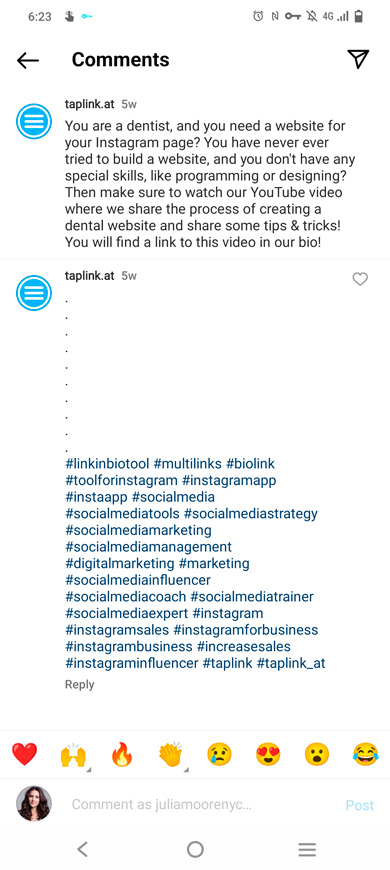
Read where you should add Instagram hashtags — in the comments or caption.
You may say we already analyzed comments in your Instagram competitors' accounts. You're right, but we looked at the numbers. Now we need to read what the users write.
This part of your Instagram competitor analysis is for understanding your audience. Users who comment on your rivals' posts are your audience too. After reading the comments, you can know its attitudes and opinions about hot topics and routine things.
Such comments analysis helps to avoid putting your foot in your mouth. You will know what to say to be in favor or at least what not to say so that you avoid their hate.
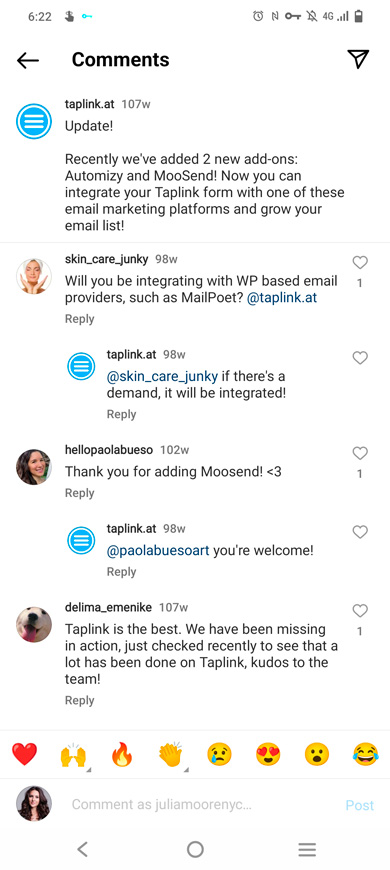
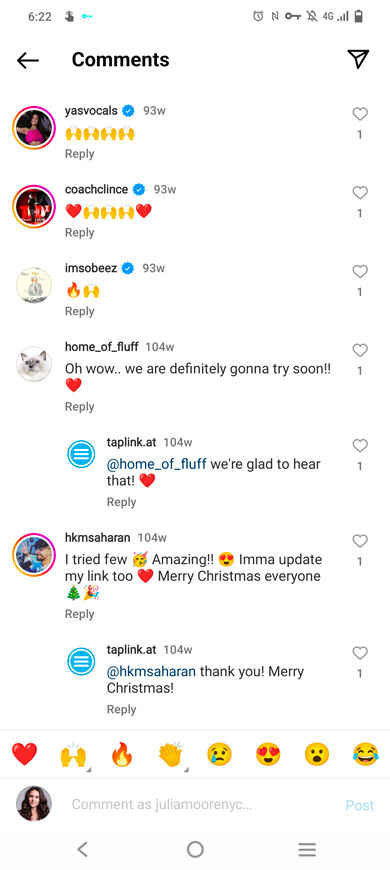
We recommend that you use free Instagram competitor analysis tools. They help to automate most of the analysis. We give examples with Phlanx and Inflact. You should analyze your competitors one by one in them.
Use Phlanx for your Instagram competitor analysis. It calculates the engagement rate. Enter a competitor's username to analyze it. Check each of your competitors this way.
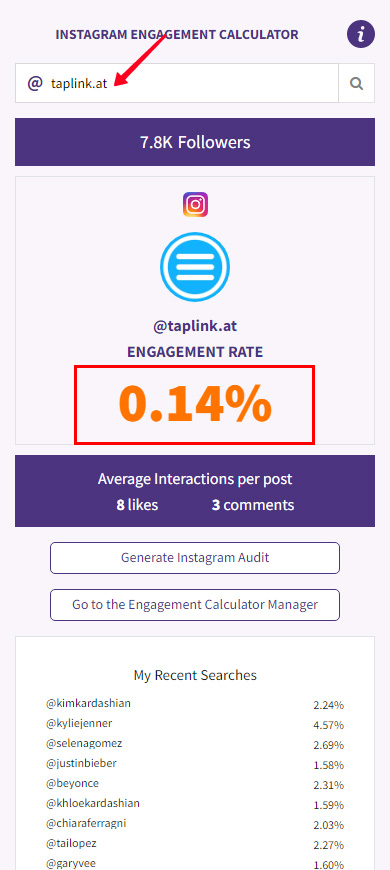

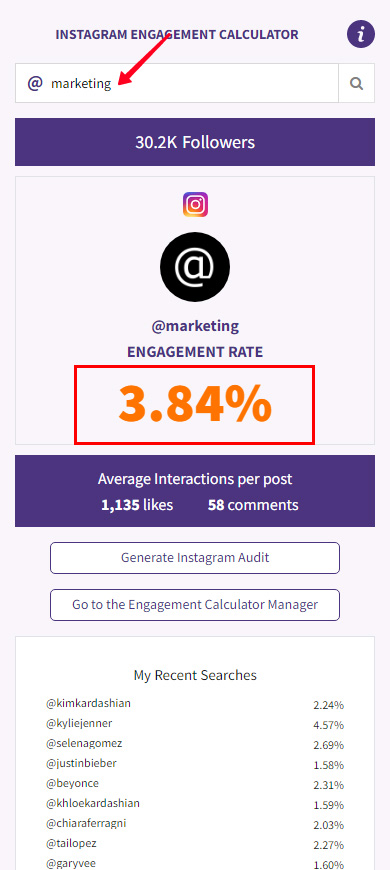
Inflact gives statistics for a big part of your Instagram competitor analysis.
- Enter an Instagram competitor's username in the search bar.
- Tap Analyze.
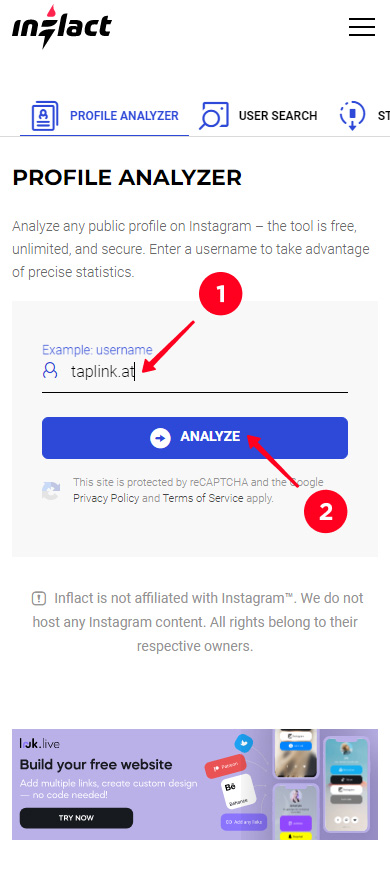
The Instagram competitor analysis you get includes the following information:
- Account statistics: follower count, likes and comments numbers.
- Posting statistics: posting time and frequency.
- Post topics: the most frequently used words in the captions are what the competitor usually posts about.



- Hashtags. You can see what hashtags your Instagram competitor uses most often.
Here is what Instagram competitors hashtag analysis looks like on Inflact:
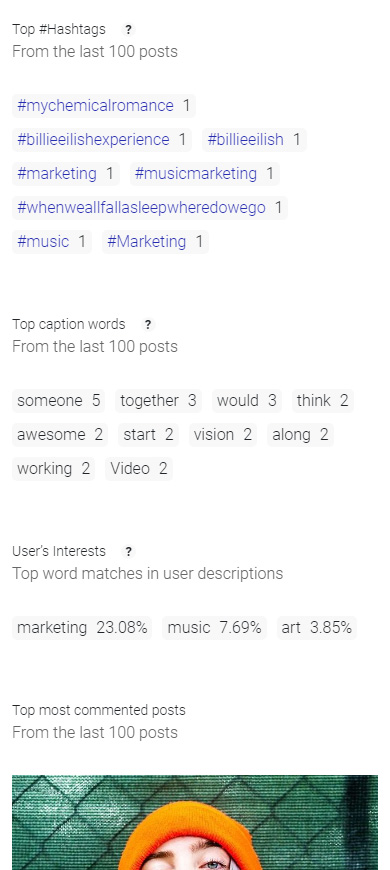
You can also see if a post is a video or photo, the number of its likes and comments. This part of the free Instagram competitor analysis is only half-automated. Still, it is more convenient to analyze the metrics in the tool where you see all the posts and their figures than in the app when you have to open each post individually to see the figures.

Analyze each of your Instagram competitors in this way.
The rest of the data for your Instagram competitor analysis should be collected manually:
- Track how the follower count changes to find the follower growth.
- Gather statistics on the ratio of photo and video posts.
- Read comments to know your audience's attitudes and opinions.
So you've analyzed your Instagram competitors. You know what they do to develop their brands on social media. Now let's see what you can do with the data to develop your brand too.
You've got some figures and words, let's make sense of them. Use the Instagram competitor analysis you have performed to improve your social media marketing strategy.
Instagram competitor analysis tells what a brand from your industry can achieve. You may aim to take over the market in a month, but the aim is doomed. Instead, aim to get what you have a chance to get.
Use the analysis results to set achievable goals when you create a social media marketing strategy. Look what results your Instagram competitors get and calculate the average numbers. Use these numbers in your marketing strategy.
Consider the number of followers in your and your competitors Instagram accounts. Analyze accounts that are nearly as big as yours to set short-term goals. Analyze the figures in accounts of the niche leaders to set long-term goals.
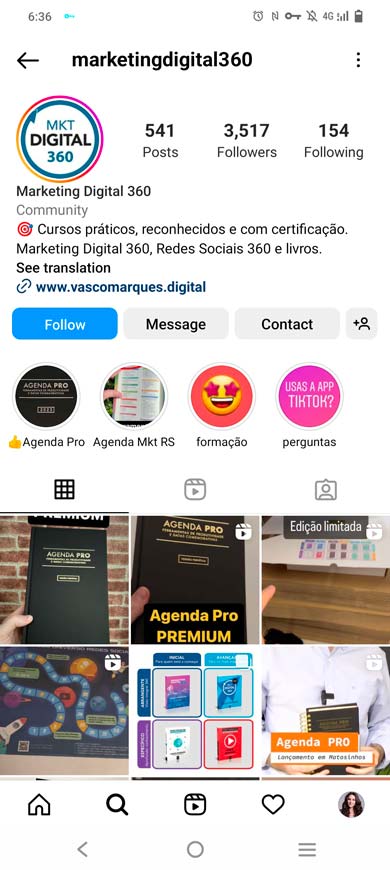
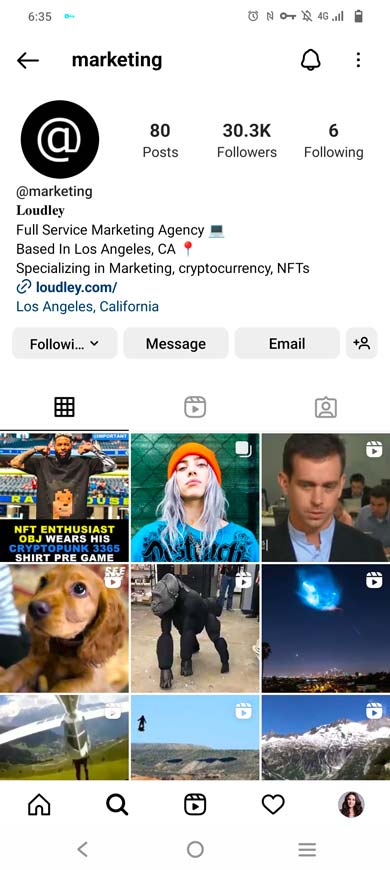
Here is an example. Your marketing goal is to increase engagement in your Instagram account. You measure it in %. You go check the engagement rate in your rivals accounts. You find the average numbers for the big and small accounts. The first number is what is possible to achieve in your industry. The second number is what you can aim to achieve in the near future.
Your Instagram competitors have tried a lot of things so you don't have to try these things yourself. You have alike audiences. You can expect your audience to react the same way as your rivals'. Use their experience to figure out what works for your audience.
Instagram competitor analysis helps to create a content plan. It tells you:
- what to post. You can see what posts get more likes. You can know the topics, whether the posts are usually photos or videos, and whether they entertain or educate. You should add more posts like that in your content plan to get more likes and followers.
- what not to post. You know what posts the audience does not like. Such posts get few likes. You know their topics and content types. Obviously, you should avoid such posts in your content plan.
- how often to post. You see when your rivals post. Find the average posting frequency and plan posting in your account according to them.
- when to post. This is about days and hours. You can see posting time in your Instagram rivals' accounts and find the average figures. Stick to the same time in your account.
When you've performed your Instagram competitor analysis, you know exactly what your audience needs and likes. Thus, you can make an offer so that they buy:
- set a reasonable price. You know the highest and the lowest prices. If you are starting, make your product price average. Sell your product for a higher price only if you are sure they will buy.
- make a good product presentation. You know what is important for your Instagram audience, and what words they speak. Thus, you can mention the features that users want to know about and emphasize those that will make your product favorable among others in your niche. You also can describe these in the words they understand, and provide examples they can relate to.
- run effective campaigns. You know what campaigns your Instagram competitors run, triggers they use. Use them too in your marketing campaigns to get better results. Here are template examples that you can use to create a landing page for your campaigns in a few minutes: car rental, web developer course, beauty salon. You only need to sign up and add your info.

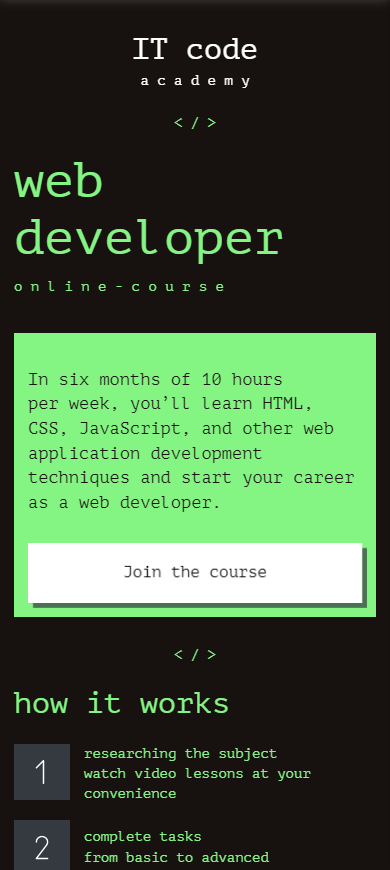

Instagram competitor analysis tells you how to be as good as your most successful rivals. Thus, you can make your sales go up. But you need to be better than your rivals to make your sales skyrocket.
There is not much you can do on your profile page to outperform your rivals. You can keep it looking good and regularly post relevant content to it. But you need more opportunities to stand out.
A link in bio tool is what gives you the opportunities to beat the competition on Instagram. Use it to stand out among the rivals:
- present your brand at its best. Instagram competitor analysis told you what your audience may want to know about you and your product. Gather all the information in one place. Also, emphasize your advantages, provide work examples, and many more.
- design a good offer. The analysis told you what words and pictures make your audience buy. So you can use them to make up a compelling offer. Provide the details to make it clear. Highlight the benefit to make it appealing. Add a trigger, like a timer, to make it look exclusive.
- make purchases easy. You don't need an Instagram competitor analysis to know that your clients buy more if they can do this easily. So give them buy and book buttons. You can link to them even from your posts, users will easily find them.
- make purchasing a fast process. There is more to link in bio tool advantages. Once a user taps the link in your bio, they instantly see the page. Your clients don't have to wait, and you don't lose the clients. This is much better than your rivals' links in their bios navigating to dense websites that load slow.
This is how it works: you sign up on Taplink to get a page for your Instagram bio. Then, you add all the information and buttons on it, you can use templates to make it quickly. After that, you add the page link to your Instagram bio. In posts and Stories, you invite users to follow the link.
Look at an example on the screenshots:
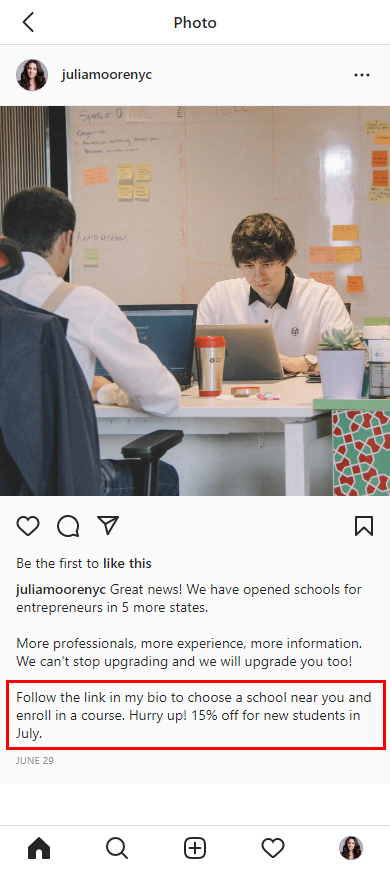

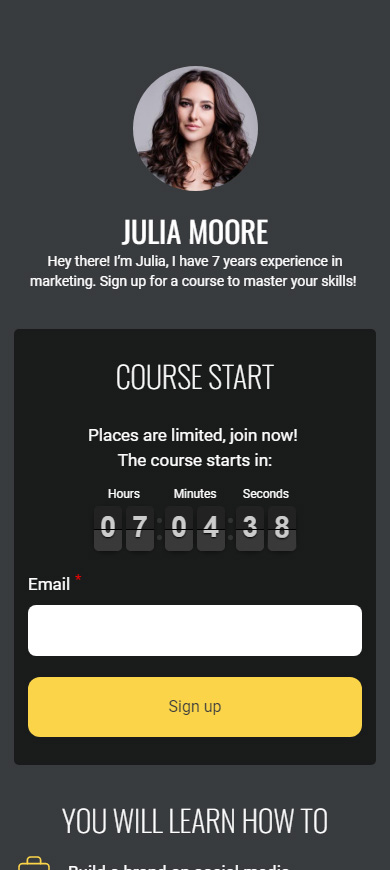
Now you know how to perform an Instagram competitor analysis. Start with searching for your competitors. Then, look at what they do and what it results in.
Use Instagram competitor analysis in your social marketing strategy. Set achievable goals. Repeat the rivals' best experience and avoid making the same mistakes. Offer what your audience wants and what it can buy. Outperform your rivals using a link in bio tool.
Spare a room for experiments, though. Try something new. You will find more things that work for your brand.
Always keep an eye on your Instagram competitors and analyze them from time to time. Then, you will be aware of the trends and updates.